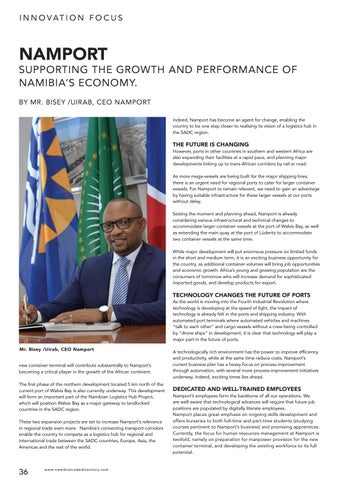I N N O V AT I O N F O C U S
NAMPORT
SUPPORTING THE GROWTH AND PERFORMANCE OF NAMIBIA’S ECONOMY. BY MR. BISEY /UIRAB, CEO NAMPORT NAMPORT – THE PREFERRED ACCESS TO SOUTHERN AFRICA
The winds of change are sweeping through the ports and shipping industry. With around 80% of global trade being seaborne and 90% of Africa’s imports and exports conducted by sea, the ocean has indeed become the focus of attention worldwide. The opportunities presented by the ocean, known as the “blue economy”, hold much promise for Namport in particular, and for Namibia in general. Operating in a country with limited internal expansion opportunities and a small domestic market, it is well known that the country has to look beyond its borders for future development possibilities. The stable political environment in Namibia continues to attract foreign direct investment and the country is gearing itself to capitalise on every opportunity that presents itself.
GEARED FOR LONG-TERM GROWTH
Namport wholeheartedly supports the fundamental ideals of the Namibian nation, which drive consolidation of peace, stability and prosperity by expanding opportunities for growth. Strategically situated to offer direct access to principal shipping routes, Namport plays a significant role in facilitating global and regional trade. During the past two decades, Namport has made great strides in growing in size and significance from a national port to a key role player in the Southern African Development Community (SADC) region. Namport is entering a new phase in its existence with emphasis on cost efficiencies, productivity and performance management. Its continued investment in port infrastructure ensures Namibia is geared for future growth opportunities. Currently under construction at the port of Walvis Bay, the New Container Terminal Project is one such mega-project that will add 750 000 TEU per annum to the current container capacity. The terminal is scheduled for commissioning in 2019. As the southern African region constitutes just more than 40% of Africa’s container throughput, the Mr. Bisey /Uirab, CEO Namport new container terminal will contribute substantially to Namport’s becoming a critical player in the growth of the African continent. The first phase of the northern development located 5 km north of the current port of Walvis Bay is also currently underway. This development will form an important part of the Namibian Logistics Hub Project, which will position Walvis Bay as a major gateway to landlocked countries in the SADC region. These two expansion projects are set to increase Namport’s relevance in regional trade even more. Namibia’s connecting transport corridors enable the country to compete as a logistics hub for regional and international trade between the SADC countries, Europe, Asia, the Americas and the rest of the world.
36
w w w. n a m i b i a t r a d e d i r e c t o r y. c o m
Indeed, Namport has become an agent for change, enabling the country to be one step closer to realising its vision of a logistics hub in the SADC region.
THE FUTURE IS CHANGING
However, ports in other countries in southern and western Africa are also expanding their facilities at a rapid pace, and planning major developments linking up to trans-African corridors by rail or road. As more mega-vessels are being built for the major shipping lines, there is an urgent need for regional ports to cater for larger container vessels. For Namport to remain relevant, we need to gain an advantage by having suitable infrastructure for these larger vessels at our ports without delay. Seizing the moment and planning ahead, Namport is already considering various infrastructural and technical changes to accommodate larger container vessels at the port of Walvis Bay, as well as extending the main quay at the port of Lüderitz to accommodate two container vessels at the same time. While major development will put enormous pressure on limited funds in the short and medium term, it is an exciting business opportunity for the country, as additional container volumes will bring job opportunities and economic growth. Africa’s young and growing population are the consumers of tomorrow who will increase demand for sophisticated imported goods, and develop products for export.
TECHNOLOGY CHANGES THE FUTURE OF PORTS
As the world is moving into the Fourth Industrial Revolution where technology is developing at the speed of light, the impact of technology is already felt in the ports and shipping industry. With automated port terminals where automated vehicles and machines “talk to each other” and cargo vessels without a crew being controlled by “drone ships” in development, it is clear that technology will play a major part in the future of ports. A technologically rich environment has the power to improve efficiency and productivity, while at the same time reduce costs. Namport’s current business plan has a heavy focus on process improvement through automation, with several more process-improvement initiatives underway. Indeed, exciting times lies ahead.
DEDICATED AND WELL-TRAINED EMPLOYEES
Namport’s employees form the backbone of all our operations. We are well aware that technological advances will require that future job positions are populated by digitally literate employees. Namport places great emphasis on ongoing skills development and offers bursaries to both full-time and part-time students (studying courses pertinent to Namport’s business) and promising apprentices. Currently, the focus for human resources management at Namport is twofold, namely on preparation for manpower provision for the new container terminal, and developing the existing workforce to its full potential.

